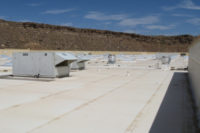A Top 10 List for Vegetative Roofing Systems
Roofing isn’t the easiest of trades, and each roofing project presents its own challenges. The installation of a traditional roofing system can be summarized, albeit simplistically, as the installation of the insulation, membrane and, possibly, surfacing, followed by the installation of all of the flashing work necessary to complete the roofing installation.

Roofing isn’t the easiest of trades, and each roofing project presents its own challenges. The installation of a traditional roofing system can be summarized, albeit simplistically, as the installation of the insulation, membrane and, possibly, surfacing, followed by the installation of all of the flashing work necessary to complete the roofing installation. If this theoretical installation is a re-roofing project, then there are more “steps,” such as removal of the existing roofing system and inspection of the substrate.
The emergence of garden or “vegetative” roofing systems has introduced a whole new level of complexity for the building professional with proportionate opportunities for miscommunication, design errors, scheduling errors, and installation mishaps. Many professionals may choose to ignore this market segment, and why not? It’s a very small portion of the U.S. roofing market, and there is a disproportionate level of expertise that one must learn to have confidence in one’s ability to complete an installation successfully. Others will jump in with both feet and learn from their mistakes - although this could prove to be a very costly method of gaining expertise. More still will understand that while this market is small, it has many drivers that are fueling its growth. These building and roofing professionals will do all they can to learn about this growing market segment, what might be important for them to know about vegetative roofing systems and what opportunities there are to expand their business.
For those that have already “jumped in,” you might have additional words of wisdom that you could add or at least concurrence as you read the following list; and for those that are trying to avoid problems and costly mistakes, hopefully this list will prove useful.

9. Not considering site/location conditions. Each project and site has its own peculiarities, and a vegetative roofing system may have additional needs that can interfere with realizing the best installation possible. For example, if the system being installed doesn’t have to be irrigated for the long term but must have intermittent irrigation for the first few years, how will that be accomplished? Is the vegetation selected appropriate for that microclimate and the climate in general where the building is located?
8. Poor timing and construction sequencing. Planting vegetation in December in Detroit probably isn’t a good idea. And using the vegetative roof as a staging area for adjacent construction is best prior to the installation of any overburden and/or any components above the waterproofing membrane.
7. Failure to utilize vegetative-free zones. These areas where the vegetative roofing system is “held back” allow for access to other components that are on the roof, such as equipment and base flashings. They also can be important when designing for wind uplift resistance and meeting codes and standards.
6. Failure to conduct meetings. The importance of communication between all of the parties that have a part in a successful installation can’t be overstressed - and using pre-bid, pre-job, and job-closeout meetings to make sure that everyone understands their roles and their responsibilities can have a huge impact on obtaining a successful installation.
5. Lack of instruction for the proper care and feeding of the vegetative roof. Too often, once the roof is installed, it is forgotten. With a vegetative roofing system, this can have horrible consequences for the property owner. The property owner should readily understand what his or her responsibilities are, including the need for irrigation, weeding, etc.
4. Improper choice of components. Some approach the selection of the components of a vegetative roofing assembly in a piecemeal manner. This can work if they understand the critical feature of each component and how it interacts with each of the other parts of the assembly. But, there can be problems if components are chosen without consideration of how they contribute to the overall performance of the system and don’t function together properly. And many have heard horror stories of those that thought that the “growing medium” was garden soil or just plain “dirt.”
3. Failure to perform water testing. The waterproofing component of a vegetative roof assembly is covered by several layers of additional components, and water testing of the waterproofing membrane is generally a very good idea. It’s much easier and less costly to fix a problem prior to the installation of the overburden.
2. Leaving out necessary components. Is there a need for a root barrier? Is there a need for a water retention layer? Does the choice of vegetation require an irrigation system? There can be complete failure of the vegetative roofing system if a component is not installed because it was considered unnecessary.
1. Forgetting that everything is secondary to keeping water out of the building. Many people are involved in an installation and, all too often, too many of those involved don’t understand the waterproofing component and how critical it is to the roof’s success. Roofing, by its very nature, is about keeping water out of a building, and this primary requirement needs to be respected by everyone involved.

Designers of green roofs must know the function of each component and how it interacts with each of the other parts of the assembly.
Roofing isn’t the easiest of trades, and each roofing project presents its own challenges. The installation of a traditional roofing system can be summarized, albeit simplistically, as the installation of the insulation, membrane and, possibly, surfacing, followed by the installation of all of the flashing work necessary to complete the roofing installation. If this theoretical installation is a re-roofing project, then there are more “steps,” such as removal of the existing roofing system and inspection of the substrate.
The emergence of garden or “vegetative” roofing systems has introduced a whole new level of complexity for the building professional with proportionate opportunities for miscommunication, design errors, scheduling errors, and installation mishaps. Many professionals may choose to ignore this market segment, and why not? It’s a very small portion of the U.S. roofing market, and there is a disproportionate level of expertise that one must learn to have confidence in one’s ability to complete an installation successfully. Others will jump in with both feet and learn from their mistakes - although this could prove to be a very costly method of gaining expertise. More still will understand that while this market is small, it has many drivers that are fueling its growth. These building and roofing professionals will do all they can to learn about this growing market segment, what might be important for them to know about vegetative roofing systems and what opportunities there are to expand their business.
For those that have already “jumped in,” you might have additional words of wisdom that you could add or at least concurrence as you read the following list; and for those that are trying to avoid problems and costly mistakes, hopefully this list will prove useful.

Photo courtesy of GAF Materials Corporation.
Top 10 Mistakes
10. Not considering general garden roof requirements. These systems do have certain requirements beyond a traditional compact/low-slope installation, such as the need to ensure the load-bearing capability/capacity of the structure.9. Not considering site/location conditions. Each project and site has its own peculiarities, and a vegetative roofing system may have additional needs that can interfere with realizing the best installation possible. For example, if the system being installed doesn’t have to be irrigated for the long term but must have intermittent irrigation for the first few years, how will that be accomplished? Is the vegetation selected appropriate for that microclimate and the climate in general where the building is located?
8. Poor timing and construction sequencing. Planting vegetation in December in Detroit probably isn’t a good idea. And using the vegetative roof as a staging area for adjacent construction is best prior to the installation of any overburden and/or any components above the waterproofing membrane.
7. Failure to utilize vegetative-free zones. These areas where the vegetative roofing system is “held back” allow for access to other components that are on the roof, such as equipment and base flashings. They also can be important when designing for wind uplift resistance and meeting codes and standards.
6. Failure to conduct meetings. The importance of communication between all of the parties that have a part in a successful installation can’t be overstressed - and using pre-bid, pre-job, and job-closeout meetings to make sure that everyone understands their roles and their responsibilities can have a huge impact on obtaining a successful installation.
5. Lack of instruction for the proper care and feeding of the vegetative roof. Too often, once the roof is installed, it is forgotten. With a vegetative roofing system, this can have horrible consequences for the property owner. The property owner should readily understand what his or her responsibilities are, including the need for irrigation, weeding, etc.
4. Improper choice of components. Some approach the selection of the components of a vegetative roofing assembly in a piecemeal manner. This can work if they understand the critical feature of each component and how it interacts with each of the other parts of the assembly. But, there can be problems if components are chosen without consideration of how they contribute to the overall performance of the system and don’t function together properly. And many have heard horror stories of those that thought that the “growing medium” was garden soil or just plain “dirt.”
3. Failure to perform water testing. The waterproofing component of a vegetative roof assembly is covered by several layers of additional components, and water testing of the waterproofing membrane is generally a very good idea. It’s much easier and less costly to fix a problem prior to the installation of the overburden.
2. Leaving out necessary components. Is there a need for a root barrier? Is there a need for a water retention layer? Does the choice of vegetation require an irrigation system? There can be complete failure of the vegetative roofing system if a component is not installed because it was considered unnecessary.
1. Forgetting that everything is secondary to keeping water out of the building. Many people are involved in an installation and, all too often, too many of those involved don’t understand the waterproofing component and how critical it is to the roof’s success. Roofing, by its very nature, is about keeping water out of a building, and this primary requirement needs to be respected by everyone involved.
Looking for a reprint of this article?
From high-res PDFs to custom plaques, order your copy today!






